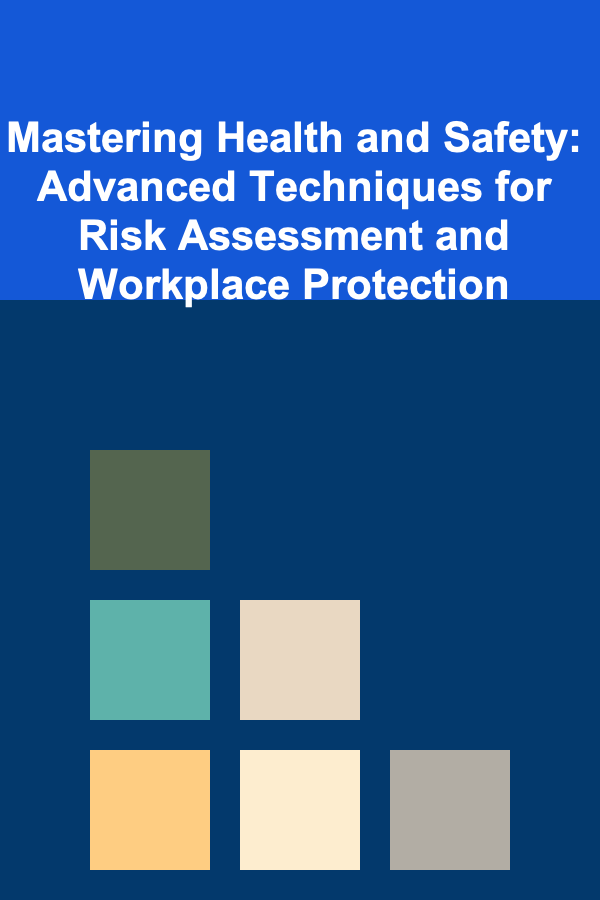
Mastering Health and Safety: Advanced Techniques for Risk Assessment and Workplace Protection
ebook include PDF & Audio bundle (Micro Guide)
$12.99$5.99
Limited Time Offer! Order within the next:

Health and safety in the workplace is crucial for ensuring the well-being of employees, maintaining productivity, and adhering to legal requirements. Whether you're a safety officer, manager, or business owner, understanding and mastering advanced techniques for risk assessment and workplace protection is fundamental to minimizing risks and promoting a healthy work environment.
In this actionable guide, we will explore the most effective and advanced methods for assessing risks and ensuring workplace safety. By the end of this article, you'll have a comprehensive understanding of the key strategies, tools, and best practices for mastering health and safety in your organization.
Understanding the Core Principles of Health and Safety
Before diving into advanced techniques, it's essential to grasp the core principles of workplace health and safety. These principles are designed to create a structured framework for preventing accidents and protecting employees.
- Hazard Identification: The first step in any risk management process is to identify hazards that could cause harm in the workplace. Hazards can be physical (e.g., machinery, chemicals), ergonomic (e.g., repetitive strain, poor workstation design), or psychosocial (e.g., stress, harassment).
- Risk Assessment: Once hazards are identified, assessing the associated risks is crucial. This involves evaluating the likelihood of an incident occurring and the severity of its potential consequences. Risk assessment helps prioritize actions based on risk levels.
- Control Measures: Once risks are assessed, the next step is to implement control measures. These measures can be preventive (e.g., training, personal protective equipment) or mitigative (e.g., emergency response plans).
- Continuous Monitoring and Review: Health and safety management should be a dynamic, ongoing process. Regularly reviewing and updating safety protocols ensures that new risks are identified and control measures remain effective.
Advanced Risk Assessment Techniques
Risk assessment is the cornerstone of effective health and safety management. By using advanced techniques, organizations can go beyond basic hazard identification and develop a more nuanced understanding of the risks employees face. Here are some advanced risk assessment techniques:
2.1. Bowtie Analysis
The Bowtie Analysis is a sophisticated risk assessment tool that visually represents how potential hazards can lead to incidents and what control measures are in place to prevent or mitigate these risks. It is especially useful in complex environments with multiple layers of risks and control measures.
How it works:
- Hazard: Identify the hazard or risk event (e.g., fire, chemical spill).
- Top Event: The moment the hazard causes an incident (e.g., explosion, injury).
- Threats: Potential causes that could lead to the top event.
- Consequences: The impact of the top event.
- Controls: Preventive and mitigative measures that reduce the likelihood of the top event occurring or lessen its consequences.
The Bowtie diagram offers a clear visual representation of risks and shows where control measures should be strengthened or added.
2.2. Failure Mode and Effects Analysis (FMEA)
FMEA is a structured, systematic approach used to identify potential failure modes in processes or systems and assess their impact on operations. It's particularly useful in industries with complex machinery or processes, such as manufacturing and engineering.
Steps in FMEA:
- Identify the Process: Break down the process into smaller components.
- Identify Potential Failure Modes: Consider all possible ways each component could fail.
- Determine Effects: Evaluate the impact of each failure on the system or organization.
- Prioritize Risks: Assign a risk priority number (RPN) based on the likelihood of occurrence, the severity of the effect, and the ability to detect the failure.
- Implement Corrective Actions: Take actions to eliminate or reduce the highest-priority risks.
FMEA provides a highly detailed analysis that can uncover hidden risks and areas of improvement in the safety management system.
2.3. Quantitative Risk Assessment (QRA)
For highly hazardous industries (e.g., oil and gas, chemical manufacturing), a Quantitative Risk Assessment (QRA) offers an in-depth mathematical model to quantify the likelihood and consequences of different risk scenarios. It combines statistical methods with physical hazard models to estimate the probability of an event and its associated cost.
Components of QRA:
- Event Tree Analysis (ETA): A model used to predict potential outcomes of a risk event.
- Fault Tree Analysis (FTA): A deductive approach that breaks down the failure into its basic components.
- Monte Carlo Simulation: A probabilistic technique that uses random sampling to estimate risk.
QRA is particularly useful for assessing catastrophic risks and ensuring compliance with strict industry standards.
2.4. Job Safety Analysis (JSA)
A Job Safety Analysis is a proactive technique used to identify and evaluate hazards in a specific job or task. JSA focuses on understanding each step of the process to identify potential risks and implement controls before an accident happens.
Steps to Conduct JSA:
- Break Down the Job: Analyze the individual steps involved in the job.
- Identify Hazards: Identify the potential hazards associated with each step.
- Assess the Risk: Determine the likelihood and severity of the identified hazards.
- Implement Controls: Determine ways to eliminate or reduce the risks, such as using protective equipment or changing work practices.
- Review and Revise: Continuously update the JSA based on feedback and new risks.
JSA is a useful technique for managing tasks that involve high-risk activities or dangerous equipment.
Workplace Protection Strategies
While risk assessment is essential, it's equally important to implement effective protection strategies. Workplace protection strategies focus on safeguarding employees from identified risks and ensuring that the workplace remains compliant with health and safety standards.
3.1. Hierarchical Control Model
The Hierarchical Control Model outlines a priority-based system for controlling risks, with the most effective measures at the top of the hierarchy. The model is designed to systematically eliminate or reduce risks, starting with the most reliable approaches.
- Elimination: Remove the hazard from the workplace entirely (e.g., replacing toxic chemicals with safer alternatives).
- Substitution: Replace hazardous substances or practices with safer alternatives.
- Engineering Controls: Use physical controls to prevent exposure (e.g., machine guards, ventilation systems).
- Administrative Controls: Implement policies and procedures that reduce exposure (e.g., rotating shifts, safety training).
- Personal Protective Equipment (PPE): As a last resort, provide employees with protective gear such as gloves, goggles, or respirators.
This model ensures that control measures are prioritized in a way that maximizes employee protection and minimizes risk.
3.2. Safety Culture and Training
Creating a safety-conscious work culture is crucial for ensuring long-term health and safety. Employees must be educated on the risks they face, how to mitigate them, and the importance of following safety procedures.
Effective Safety Training:
- Job-Specific Training: Tailor training programs to specific tasks and roles to address the unique risks employees face.
- Behavioral Safety: Focus on encouraging safe behaviors and attitudes through reinforcement and recognition.
- Emergency Response Drills: Regularly conduct drills for fire evacuations, first-aid procedures, and other emergency situations to ensure employees know how to react in crisis situations.
A strong safety culture encourages employees to be proactive about safety, report hazards, and contribute to risk-reduction efforts.
3.3. Health Surveillance Programs
For some workplace risks, especially those involving exposure to hazardous materials or repetitive tasks, implementing health surveillance programs is necessary. These programs help detect early signs of work-related illnesses and ensure that employees receive timely medical attention.
Components of Health Surveillance:
- Pre-Employment Health Checks: Assess employees' health before they begin work to establish a baseline.
- Regular Monitoring: Regular check-ups to monitor employees' health status, especially if they work in environments with long-term exposure to risks.
- Post-Incident Health Evaluations: Evaluate employees after an accident or exposure to ensure there are no lingering health effects.
Health surveillance can help catch problems early, preventing more severe health outcomes.
The Role of Technology in Health and Safety
Advances in technology are revolutionizing the way businesses manage health and safety. From wearable devices to AI-powered risk analysis tools, here are some examples of how technology is enhancing workplace safety.
- Wearable Technology: Devices that monitor workers' movements and vitals can help detect fatigue, overexertion, or hazardous conditions in real-time. For example, smart helmets and sensors can alert workers to unsafe temperatures or high levels of toxic gases.
- AI and Machine Learning: These technologies can process vast amounts of data to predict potential risks and recommend preventive measures. AI can also help analyze accident reports and near misses to identify patterns and trends.
- Safety Management Software: Tools like SafetyCulture, RISK360, and others provide digital platforms for managing risks, conducting audits, and ensuring compliance with safety standards. These tools help streamline safety management and improve incident reporting.
Conclusion
Mastering health and safety requires a combination of advanced risk assessment techniques and effective protection strategies. By utilizing sophisticated tools such as Bowtie Analysis, FMEA, and QRA, and applying the Hierarchical Control Model to implement protective measures, organizations can significantly reduce risks and improve employee well-being.
Building a strong safety culture, providing ongoing training, and leveraging technology will further enhance workplace protection. By taking these steps, you can ensure that your workplace not only meets legal requirements but also creates an environment where employees can thrive without unnecessary risks.

Best Organization Tools for Small Business Owners
Read More
How to Create VR Journalism Pieces
Read More
How to Optimize Your Yard Sale for Online Shoppers
Read More
How to Organize Your Home for Stress-Free Entertaining
Read More
How to Protect Your Home from Dust and Allergens
Read More
How to Secure Your Home on a Budget Without Sacrificing Safety
Read MoreOther Products

Best Organization Tools for Small Business Owners
Read More
How to Create VR Journalism Pieces
Read More
How to Optimize Your Yard Sale for Online Shoppers
Read More
How to Organize Your Home for Stress-Free Entertaining
Read More
How to Protect Your Home from Dust and Allergens
Read More